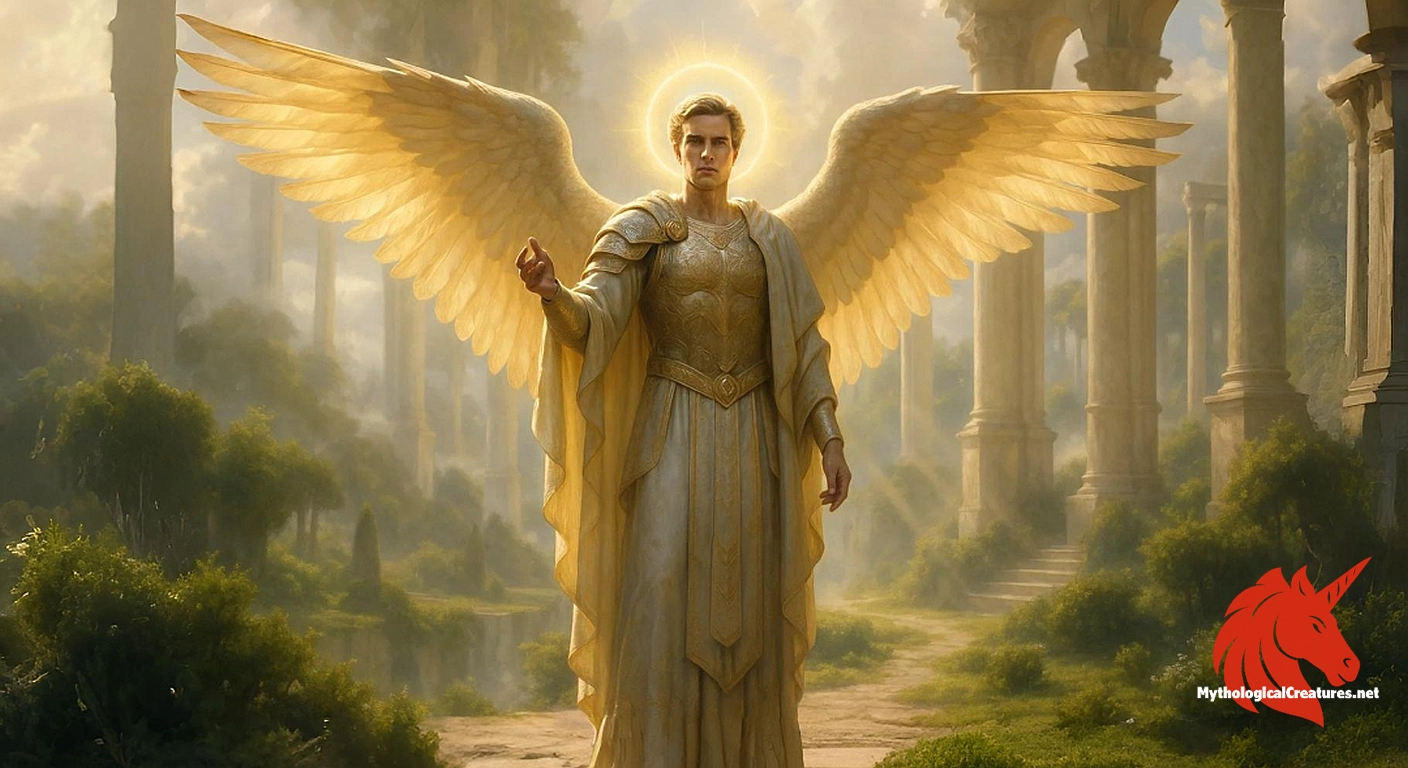Zadkiel: Zadkiel, also known as Hasdiel, is an archangel in Jewish and Christian angelology embodying divine mercy and righteousness.

Zadkiel
Zadkiel - Represents the balance of divine justice and mercy, often invoked for forgiveness and compassion.
Origins & First Encounters
Zadkiel is a prominent archangel whose name resonates deeply with the ideals of divine righteousness and mercy. His very name, meaning 'God is my Righteousness', encapsulates a commitment to ethical integrity and spiritual compassion. Emerging from layers of Jewish mysticism and later Christian angelology, his presence became a bridge between divine justice and the solace of forgiveness. The early mentions of Zadkiel are sparse, but over time, mystical traditions and later theological works enriched his narrative with profound moral implications. His depiction as a mediator and guide in complex moral dilemmas reflects a broader cultural trend towards reconciling strict divine judgment with mercy. Diverse traditions attribute various significant interventions to him, including narratives where he plays a role in critical biblical moments. His evolution as a celestial figure mirrors the changing human understanding of divine attributes over time. The archangel’s lore has been shaped by both ancient texts and folk traditions, making him an enduring symbol of benevolence across cultures. His story resonates with those who seek balance between accountability and compassion. Ultimately, Zadkiel remains a compelling figure, inspiring both reverence and introspective enquiry in the realms of spirituality and ethics.
Source Texts & Tale Variants
The narrative of Zadkiel is woven through a rich assortment of texts spanning several centuries and cultural milieus. While he is not heavily featured in early canonical scriptures, later mystical writings, such as those found in Kabbalistic literature, afford him a significant role. Apocryphal accounts and medieval treatises contribute additional layers to his representation, often highlighting his merciful disposition. In several traditions, he appears under the alternate name Hasdiel, further complicating and enriching his mythological profile. The details of his divine interventions and character attributes emerge from a convergence of oral traditions, mystic interpretations, and later written commentaries. Various manuscripts offer different versions of his deeds, reflecting both the fluidity and the universality of his emblematic presence. Some texts even allude to his subtle intervention in pivotal narrative moments that underscore themes of forgiveness and moral rectitude. Over time, the literary and mystical sources have blended to portray him as a multifaceted guardian of compassion and divine truth. His story serves as an interpretive canvas where mystical insights and human experiences coalesce. This complex textual heritage continues to stimulate scholarly debate and spiritual reflection across diverse communities.
Form & Powers
Iconographic depictions of Zadkiel blend celestial elegance with a touch of human simplicity, resulting in enduring visual motifs of divine beauty. His representation often features expansive wings that shimmer with hues of soft blue and violet, symbolising a serene yet potent presence. Artists frequently imbue his figure with a calm, introspective countenance, suggesting both wisdom and compassion. Flowing, ethereal robes often drape his form, marked by intricate details that hint at his celestial origin. The depictions frequently elevate his stature to a superhuman level, allowing him to dominate the canvas with otherworldly grace. His eyes, rendered as luminous windows to the divine, are said to capture the essence of mercy and understanding. Traditional iconography sometimes grants him accessories such as a sceptre or scroll, emblems of divine order and the dispensation of grace. In many Renaissance and Baroque works, the subtle interplay of light and shadow accentuates his dual role as both arbiter of justice and agent of mercy. Over centuries, his physical portrayal expanded from minimalist sketches to richly detailed compositions, mirroring evolving artistic sensibilities. Each visual portrayal invites the observer to connect with the timeless qualities of compassion and moral integrity that Zadkiel embodies.
Regional Faces
The image of Zadkiel has evolved significantly as it traversed geographical and cultural boundaries, adapting to local spiritual needs and artistic conventions. In the Jewish mystical tradition, his identity is intricately linked to the symbolic framework of the Tree of Life, where his presence is interwoven with themes of balance and renewal. In European Christian art, he is frequently portrayed as a dignified and benevolent figure, with depictions that emphasise gentleness and forgiveness. Eastern Orthodox traditions sometimes render him with a more austere quality, reflecting nuanced theological distinctions in the portrayal of celestial hierarchies. Across the Middle Eastern landscapes where his lore originally took root, his character is embedded in traditions that celebrate divine mercy tempered with accountability. Modern reinterpretations in Western cultures often blend his ancient attributes with New Age sensibilities, positioning him as a guide in personal spiritual journeys. Variations in his iconography, such as differences in attire or colour symbolism, reflect these regional interpretative differences. Some local traditions have even integrated indigenous motifs with his image, further enriching his mythological tapestry. The regional diversity in his depictions highlights a shared reverence for compassion, while simultaneously showcasing the dynamic interplay between local culture and universal spirituality. These adaptations ensure that Zadkiel’s enduring legacy remains both specific to local contexts and transcendent in its universal appeal.
Cultural Parallels
Zadkiel’s role as a divine mediator of mercy creates compelling parallels with similar figures in other mythological and spiritual traditions. His dual qualities of compassion and moral righteousness resonate with the attributes of other archangels, whose balanced portrayals encourage concepts of both protection and benevolence. In Eastern traditions, the compassionate qualities of bodhisattvas, such as Kuan Yin, mirror his role in alleviating suffering and promoting forgiveness. Similar themes emerge in various cultural mythologies where deities and celestial beings act as arbiters between divine judgment and human frailty. These comparative reflections reveal a broader human preoccupation with the balance between justice and mercy. Despite regional differences, the innate desire to transcend harsh retribution through compassionate intervention is evident across these traditions. His portrayal can be seen as a counterpoint to more warlike celestial figures, underscoring the diverse manifestations of divine influence. Cross-cultural analyses highlight how different communities have embraced the ideal of mercy, often elevating it to a cosmic principle embodied by figures like Zadkiel. This interconnection serves as a reminder of the shared human longing for understanding and redemption. Thus, by comparing him to other mythic beings, one gains a deeper insight into the universal quest for balance between human imperfection and divine benevolence.
Legacy & Modern Evolution
The legacy of Zadkiel is a rich tapestry that reflects a continual evolution from ancient mysticism to modern spiritual discourse. Historically, his character transitioned from a subtle, almost ephemeral presence in early mystical texts to a robust symbol of divine compassion in later religious narratives. Medieval iconography and illuminated manuscripts helped to cement his status as the archangel of mercy, often presenting him in a dignified, approachable manner. Over time, his image has been reinterpreted by various artists, theologians, and spiritual practitioners, each imbuing his representation with contemporary relevance. In modern times, Zadkiel is frequently invoked in New Age practices and meditative traditions as a source of inner healing and moral guidance. His attributes are celebrated not only in religious liturgies but also in artistic expressions that span literature, music, and visual arts. The evolution of his portrayal mirrors broader shifts in the human understanding of divine qualities, from strict retributive justice to a more nuanced appreciation of mercy and forgiveness. His enduring influence is seen in the way modern spirituality embraces his timeless message of compassion. The integration of ancient symbolism with current cultural narratives continues to inspire a deep respect for his divine role. Ultimately, Zadkiel’s historical evolution and modern legacy underscore his perpetual appeal as a beacon of hope and moral renewal.
Interesting Fact
Some traditions credit Zadkiel with intervening in biblical narratives, symbolically representing the power of mercy to avert divine wrath.
Quick Creature Info
Features:
Associations:
Our Mythic Legendary Rating:

Also Sometimes Known As:
Habitat:
Supernatural Powers:
Physical Attributes:
Abilities:
Behavior:
Weaknesses:
Lore:
Related Creatures, Tales or Lore
- MMichael
- GGabriel
- RRaphael
References
Discover Another Mythical Legend You May Not Have Heard Of?
Uncover the mysteries of ancient folklore and expand your knowledge of legendary beings from cultures around the world.
Dare to Meet the Irawaru....
Mythical Disclaimer: The images and data on this site are derived from various historical and literary sources, but we have found that many myths often have multiple versions and interpretations across references, sometimes contradictory. As a result, these creature depictions are artistic interpretations—imaginative blends of folklore, legend, and a dash of AI guesswork. Because creature descriptions vary widely, our illustrations and accompanying information represent our best effort to honor mythology while bridging creative gaps. Enjoy these interpretations—just remember, we've done our best to respect the stories and validate available data, but in the realm of mythology, details often shift, imagination leads the way, and nothing is ever set in stone!
Curated by the Mythological Creatures Team (rev. May 2025)
